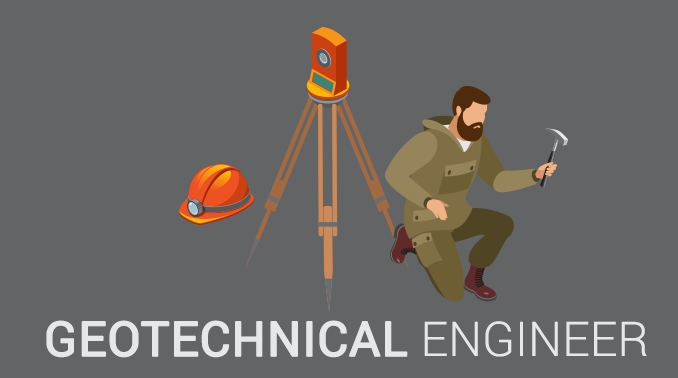The Ultimate Guide To Geotheta
The Ultimate Guide To Geotheta
Blog Article
The Basic Principles Of Geotheta
Table of ContentsThe Greatest Guide To GeothetaThe Single Strategy To Use For GeothetaGet This Report about GeothetaThe Buzz on GeothetaThings about Geotheta

They perform site investigations, gather examples, perform lab examinations, and assess data to assess the viability of the ground for building and construction tasks - Consulting Engineer. Based upon their findings, geotechnical designers provide suggestions for structure design, slope stability, maintaining frameworks, and reduction of geotechnical threats. They collaborate with various other experts, such as designers, structural designers, and building and construction groups, to make certain that geotechnical factors to consider are incorporated right into the total task layout and execution
By assessing the behavior and residential or commercial properties of dirt and rock, they can recognize possible geotechnical threats such as landslides, dirt negotiation, or incline instability. Their experience aids protect against failings or crashes that might threaten lives and property. Below are some thorough obligations and duties of a geotechnical designer: Site Investigation: Geotechnical engineers conduct website investigations to gather information on subsurface problems.
They analyze the information to understand the homes and habits of the soil and rock, including their stamina, permeability, compaction attributes, and groundwater problems. Geotechnical Evaluation and Style: Geotechnical designers examine the information gathered during site investigations to assess the stability and viability of the website for building and construction tasks. They execute geotechnical estimations and modeling to examine aspects such as bearing capacity, settlement, incline security, side planet stress, and groundwater flow.
The Definitive Guide for Geotheta
Foundation Layout: Geotechnical engineers play a crucial duty in creating foundations that can securely support the intended structure. They examine the dirt conditions and lots requirements to figure out the proper foundation kind, such as shallow structures (e.g., footings), deep structures (e.g (https://www.tumblr.com/geotheta/757702666915840000/geotheta-has-grown-exponentially-since?source=share)., heaps), or specialized strategies like dirt renovation. They take into consideration variables such as negotiation limitations, bearing ability, and soil-structure communication to establish ideal foundation layouts
They assess building plans, display website activities, and conduct area assessments to verify that the design referrals are complied with. If unexpected geotechnical issues emerge, they evaluate the situation and provide referrals for remediation or adjustments to the layout. Danger Assessment and Mitigation: Geotechnical designers assess geotechnical hazards and dangers connected with the task site, such as landslides, liquefaction, or soil erosion.

Partnership and Communication: Geotechnical designers work closely with various other professionals associated with a job, such as architects, architectural engineers, and building and construction groups. Effective interaction and partnership are important to incorporate geotechnical considerations right into the general task style and construction procedure. Geotechnical engineers give technological competence, solution inquiries, and ensure that geotechnical demands are met.
The Of Geotheta
Here are some sorts of geotechnical designers: Structure Designer: Structure engineers concentrate on making and evaluating structures for frameworks. They assess the soil conditions, tons demands, and website qualities to determine the most suitable structure kind and design, such as shallow foundations, deep structures, or specialized techniques like stack foundations.
They examine the aspects affecting incline security, such as dirt homes, groundwater conditions, and slope geometry, and establish methods to avoid incline failures and mitigate threats. Quake Designer: Quake designers focus on examining and making frameworks to hold up against seismic pressures. They analyze the seismic threat of a website, review dirt liquefaction capacity, and develop seismic design criteria to ensure the safety and security and strength of frameworks throughout quakes.
They execute area testing, gather examples, and assess the gathered information to identify the soil properties, geologic developments, and groundwater problems at a site. Geotechnical Instrumentation Designer: Geotechnical instrumentation designers focus on monitoring and measuring the actions of soil, rock, and structures. They mount and keep instrumentation systems that keep an eye on elements such as dirt negotiation, groundwater levels, incline movements, and architectural variations to evaluate performance and provide very early cautions of prospective concerns.
Indicators on Geotheta You Need To Know
They conduct tests such as triaxial examinations, loan consolidation tests, straight shear tests, and leaks in the structure examinations to gather data for geotechnical evaluation and style. Geosynthetics Designer: Geosynthetics engineers focus on the design and application of geosynthetic materials, such as geotextiles, geogrids, and geomembranes. They utilize these products to boost soil security, reinforce slopes, supply drainage remedies, and control erosion.
They have a tendency to be investigative individuals, which means they're intellectual, introspective, and curious. They are interested, systematic, rational, logical, and sensible. Some of them are likewise social, suggesting they're kind, charitable, cooperative, client, caring, helpful, compassionate, sensible, and pleasant. Does this audio like you? Take our find out this here cost-free career test to figure out if geotechnical engineer is among your top career matches.
In the workplace setting, geotechnical designers use specialized software program devices to execute computations, develop styles, and evaluate information. They prepare reports, review task specs, communicate with clients and team participants, and coordinate task tasks. The office setting gives a conducive setting for research study, analysis, and collaboration with other professionals associated with the job.
The Best Strategy To Use For Geotheta
They regularly go to task websites to perform site examinations, evaluate geotechnical problems, and gather data for evaluation. These sees involve taking a trip to various locations, often in remote or challenging surfaces. Geotechnical designers may execute soil sampling, conduct examinations, and screen building and construction activities to make certain that the geotechnical elements of the job are being executed properly.
Geotechnical engineers likewise function in specialized geotechnical laboratories. Geotechnical laboratory engineers work extensively in these environments, managing screening tools, running tools, and videotaping information.
Report this page